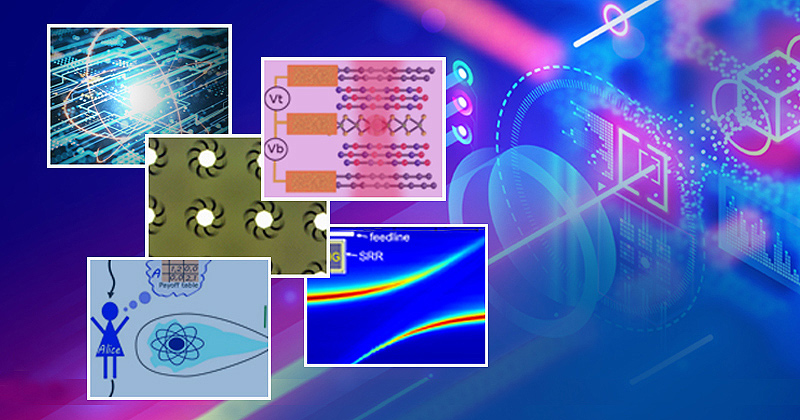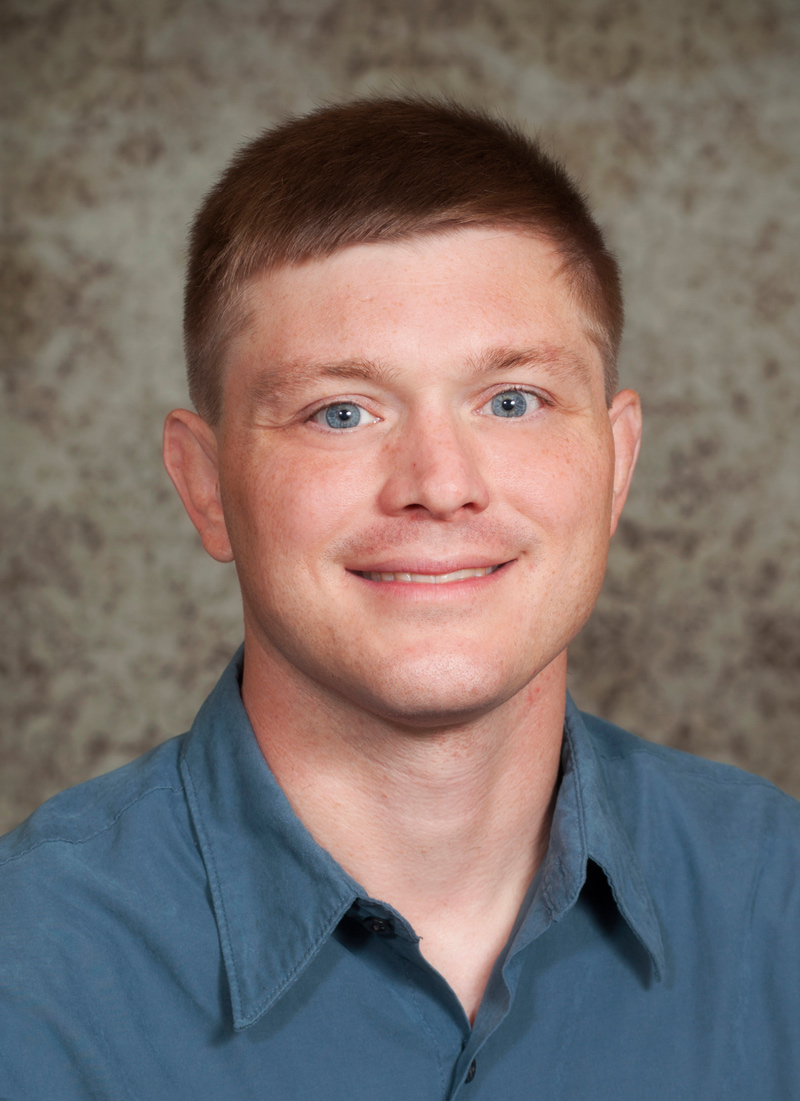


Quantum computing workforce
Photo by Ambre Alexander | Illustration by Cindy Dolan March 20, 2023
New graduate program puts UD in select company with in-demand degrees
It’s a Sunday morning in the fall, and you have four stops to make before your guests arrive to watch the Eagles game. You just found out your friends are bringing their friends, so you have to hit a grocery store to buy more food. Also, the propane tank for your grill is empty. You need to pick up your blood pressure medication at the pharmacy — especially since today’s opponent is the Cowboys, as well as because of the wings of fire you are planning to cook — and supplies must be purchased for your kid’s science project that is due tomorrow. You’re running out of time, so what is the quickest order in which to make these stops?
Otherwise known as the traveling salesman’s problem, to figure this out you need to calculate the most efficient of 24 distinct routes if you don’t want to end up with guacamole on your face. Sure, you can run through all the combinations on your favorite mapping app, but what if you have to add a stop at the pet supply store too? Now there are 120 potential routes. Soon, thanks to quantum computers, strategizing to-do lists like this can be simplified.
“There are a number of types of computations where quantum computers can outperform classical ones,” said Matthew Doty, professor of materials science and engineering at the University of Delaware and program director of UD’s new interdisciplinary Quantum Science and Engineering program. “The only way a standard classical computer can solve the traveling salesman’s problem is to run through all the permutations, calculate how long it takes for each, and then give you a rank-ordered list from fastest to slowest. A quantum computer can find the fastest solution in one pass.”

With a curriculum designed to rapidly introduce students to the fundamental concepts of quantum mechanics and quantum information processing, as well as establish a shared vocabulary and knowledge base that accelerates collaboration across disciplines, the program equips students with the professional skills required for in-demand career opportunities expected to increase exponentially. Maximizing hands-on, project-based learning, students are trained to use state-of-the art equipment ranging from semiconductor nanofabrication tools to high performance computers.
Classical computers, like the chips in our phones or laptops, are binary logical devices that encode information in bits representing states of 0 or 1. In contrast, quantum computers use qubits that can simultaneously be “partly 0” and “partly 1.” This ability to exist in more than one state at the same time is known as a superposition. When you add conditional interactions between the qubits, the superposition states of each qubit become entangled, which essentially means that the state of one depends on the state of another. This effectively leads to a massively parallel processing of all of the possibilities, and thus the computational power increases exponentially with the number of qubits. As a result, quantum computing is significantly faster and more powerful than classic computing for a variety of complex problems. According to the Harvard Business Review, “Just as classical computers reduced the cost of arithmetic, quantum presents a similar cost reduction to calculating daunting combinatoric problems.”
Numerous technological applications
While an Eagles watch party might not warrant a need for trailblazing innovation, unless of course it is during the playoffs, quantum technology can have great impact on countless sectors, including transportation and logistics, materials discovery and drug development, artificial intelligence, financial services, and manufacturing. A personal errand list of four or five stops may not be so daunting, but think of the delivery service making 10 stops while optimizing the best of more than 3.6 million potential routes.
The ideas of quantum computing largely developed within physics departments. Doty said a major disconnect in the training of the workforce needed to develop quantum technologies is that physicists are generally not trained to think in terms of scalability and reliability. Engineers, on the other hand, tend to be extensively trained in scalability and reliability, but not in the principles of quantum information science.
“The biggest need of the industry is people who are trained somewhere down the middle with enough quantum science technical background from the physics point of view to be able to understand what they need to do and why it matters for the purposes of this technology, and also enough engineering education to be able to think like engineers in terms of scalability, reliability and programming,” said Doty.
Rampant growth expected
Doty said quantum technology is exploding, and his prediction is heavily supported. A report by Fortune Business Insights, “Quantum Computing Market, 2021-2028,” said the global quantum computing market is expected to grow from $486.1 million in 2021 to $3,180.9 million in 2028, which equates to a compound annual growth rate of 30.8%. Acknowledging this potential, the Royal Swedish Academy of Sciences awarded the 2022 Nobel Prize in Physics to Alain Aspect, John F. Clauser and Anton Zellinger who have each conducted groundbreaking experiments using entangled quantum states and produced results that have cleared the way for new technology based on quantum information.
“An industry growing at over 30% per year is just unbelievable,” said Doty. “IBM, Microsoft, HP, Northrop Grumman and Google all have big quantum initiatives, as do many smaller businesses and startups as well. This is a huge new technology that is growing really fast.”
In need of skilled workers
With this growth comes a demand for workers, and McKinsey Digital’s June 2022 “Quantum Technology Monitor” cites a dearth of available talent. The report noted that quantum technology job postings in 2021 outpaced qualified talent by nearly 300%. Recognizing this need, the University of Delaware introduced its master’s and doctoral degrees in quantum science and engineering late in 2021 and is in select company. Harvard University and the University of Chicago are the only other U.S. universities offering a doctorate in the field, and there are only about a dozen institutions in the country offering a master’s degree in quantum technology.
“There is a strong market for employees coming out of both the master’s and Ph.D. pipelines,” Doty said. “Our program is designed to train a quantum workforce with the skills needed to realize this technological revolution. As we were developing the program, we met with a lot of industry people, and they all told us they have a hard time finding enough workers for the positions they have.”
STEM students welcome
Featuring faculty representing UD’s College of Arts and Sciences and College of Engineering from physics and astronomy, mathematics, computer and information sciences, and several engineering concentrations, the interdisciplinary program in quantum science and engineering leverages the talents of diverse experts and is housed within the University’s Graduate College. With so much of quantum technology yet to be discovered and developed, Doty said nobody knows the rules yet, and students in the program need to have curious minds, a willingness to work hard and invent new things, and an ability and desire to embrace teamwork.
“We designed the program to be open to people coming from a wide range of STEM [science technology, engineering and mathematics] backgrounds, so you don’t already have to know quantum mechanics,” Doty said. “You don’t have to come out of a physics program and know exactly what quantum mechanics means. You will take a quantum science course with us in the first semester and we will teach you what it means.”
To get students on-the-job experience, expose them to the work being done in the industry and help them get a foot in the door for later employment, internships play a significant role in UD’s program. Students in the first class are interviewing for summer 2023 internships with several major companies.
Quantum pioneer
Doty, who earned a bachelor’s degree in physics from Penn State University in 1998 and a master’s and a doctorate in physics from the University of California, Santa Barbara in 2001 and 2004, respectively, did his doctoral research on materials that could be used for quantum computers.
“At that point, it was a cool idea that could have huge impacts, but we did not know how we were going to realize it at scale,” Doty said. “Now, not only are multiple companies making quantum computers, their capabilities are growing incredibly fast. Nobody knew how to do that 20 years ago. Never underestimate the power of a large number of creative people pounding away on something.”
Quantum technology coming soon
Doty said quantum computing will gradually become part of our everyday lives. Though the devices we carry with us, like phones and laptops, will likely continue to be based on classical computing technologies, IBM and other companies are already offering cloudlike services that enable us to outsource specific problems that can be solved by quantum computers. That outsourcing of the hardest parts of a calculation is likely to expand and become increasingly integrated into apps.
While quantum computing is likely the best known quantum technology, other facets include quantum sensing, which can be applied in a variety of ways to make a much more sensitive probe of the environment, and quantum key distribution, a fundamentally secure way of transmitting information.
“Quantum technologies are already in use, and fields as diverse as financial services to bioimaging are trying to figure out how quickly they will expand and how they can be best utilized.” Doty said.
Whether students are pursuing the master’s or doctorate at UD, they follow one of three tracks: quantum nanotechnology, quantum theory or quantum algorithms and computation. For more information, visit qse.udel.edu.
Contact Us
Have a UDaily story idea?
Contact us at ocm@udel.edu
Members of the press
Contact us at 302-831-NEWS or visit the Media Relations website

